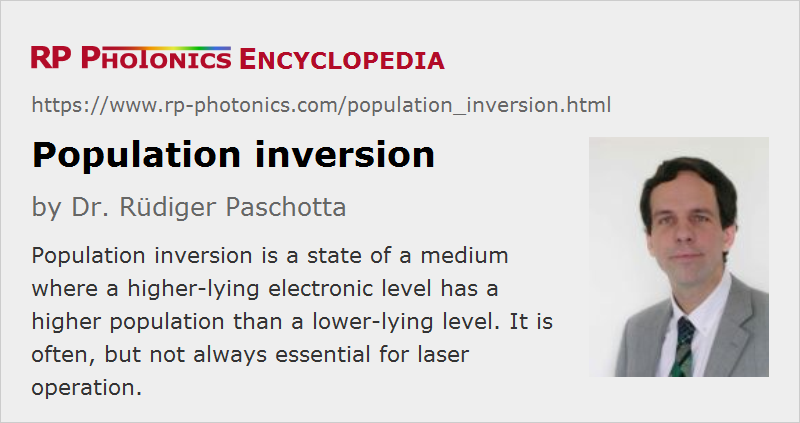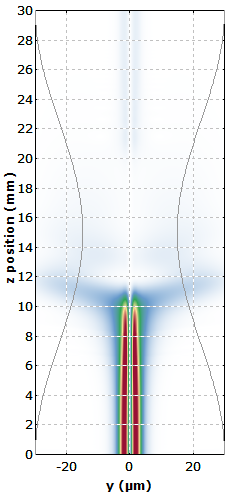Population Inversion
Definition: a state of a medium where a higher-lying electronic level has a higher population than a lower-lying level
German: Besetzungsinversion
Category: physical foundations
How to cite the article; suggest additional literature
Author: Dr. Rüdiger Paschotta
In simple cases, a laser transition, on which optical gain occurs as a result of stimulated emission, involves only two (nondegenerate) energy levels of the active atoms or ions of the gain medium: an upper and a lower laser level. The transition cross sections for absorption and for stimulated emission must then be the same (for any given wavelength), and a positive net gain (i.e., more gain than absorption) can occur only when the population of the upper laser level is higher than that of the lower level (i.e. more laser-active atoms or ions are in the higher level). In other words, more laser-active ions are in the upper state than in the lower state. This condition of the laser medium is called population inversion.
Population inversion is a state of the system which deviates from thermal equilibrium: in thermal equilibrium, the population of the lower level is always higher, and a positive net gain can never occur. Formally, population inversion is sometimes described as a state with a negative temperature. In many cases, it is achieved by optical pumping.
In most solid-state lasers, the concept of population inversion is not directly applicable, because the upper and lower energy levels actually consist of large numbers of slightly different energy levels. Typical models involve upper level and lower level manifolds, each consisting of different Stark levels, which can in addition be subject to inhomogeneous broadening. Within each level manifold, thermal equilibrium is reached within picoseconds due to the strong coupling via phonons. It is then convenient to use effective transition cross sections, which take into account the thermal population distribution within the manifolds and are in general different for absorption and stimulated emission. This shows that population inversion in the sense of > 50% inversion is not required for obtaining optical amplification: for long wavelengths, where the emission is typically much stronger than the absorption, gain is achieved even for fairly low excitation levels.
The latter phenomenon should not be confused with lasing without inversion, where laser amplification is achieved in a simple atomic system by means of quantum coherence.
Questions and Comments from Users
Here you can submit questions and comments. As far as they get accepted by the author, they will appear above this paragraph together with the author’s answer. The author will decide on acceptance based on certain criteria. Essentially, the issue must be of sufficiently broad interest.
Please do not enter personal data here; we would otherwise delete it soon. (See also our privacy declaration.) If you wish to receive personal feedback or consultancy from the author, please contact him e.g. via e-mail.
By submitting the information, you give your consent to the potential publication of your inputs on our website according to our rules. (If you later retract your consent, we will delete those inputs.) As your inputs are first reviewed by the author, they may be published with some delay.
Bibliography
| [1] | A. Javan, “Possibility of producing of negative temperature in gas discharges”, Phys. Rev. Lett. 3 (2), 87 (1958), doi:10.1103/PhysRevLett.3.87 |
See also: optical amplifiers, laser transitions, transition cross sections, lasing without inversion, rate equation modeling
and other articles in the category physical foundations
 |






If you like this page, please share the link with your friends and colleagues, e.g. via social media:
These sharing buttons are implemented in a privacy-friendly way!